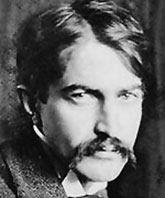Stephen Crane
Critique

Born
1871
Died
1900
Publications
Novels, stories, poetry
Writing language
English
Literature
• The Red Badge of Courage (1895)
Novels
• The Red Badge of Courage (1895)
Stories
• The Open Boat (1897)
Story Collections
• The Adventures of Sherlock Holmes (1892)
American Literature
• The Red Badge of Courage (1895)
Portrait of three artists as a young man
A short life, a popular reputation resting on one slim novel—and a gigantic influence on modern writers. In his twenty-eight and a half years, Stephen Crane crammed an awful lot of work into different literary forms, most of it still worth reading more than a century later.
Born in Newark, New Jersey, and attending Syracuse University, Crane became a journalist in New York. Much of his subsequent writing was journalism, exposing local corruption, making enemies of police, and covering foreign wars.
He couldn't find a publisher for his first short novel, Maggie: A Girl of the Streets (1893), a grim study of a prostitute and life in the slums. He borrowed money to print it himself—selling all of nearly one hundred copies.
Failing as a novelist, he turned to poetry and found a reluctant publisher for The Black Riders and Other Lines (1895). Today these brief, blunt poems with their caustic comments about a capricious, uncaring God and the meaninglessness of life can seem at first rather sophomoric, but they grow strangely on you once you get used to Crane's directness. At the time they won him attention and some later critics have claimed they were precursors of the French symbolist movement and of the imagism that has dominated twentieth-century poetry, though this seems a stretch. Crane himself had no such pretensions and didn't even like to call his untitled free verse "poetry"—it was just some "lines".
Realistic warfare
It was his second short novel, The Red Badge of Courage (1895), that made him famous. It concerns a young Union soldier who loses and then recovers his bravery during the American Civil War. It was praised by veterans for its realistic depiction of the experience of fighting in the war, despite Crane being born years after the conflict had ended.
A few years after Red Badge, as a correspondent covering the Spanish-American War, he was heading for Cuba when his steamship sank and he escaped in a dinghy. The drama was captured in his best-known short story, "The Open Boat" (1897, collected with other stories in 1898).
He also covered the Greco-Turkish War in Greece, and afterwards settled in Sussex, England with a common-law wife.
In his last five years he published other stories in magazines and books, many of which are still often anthologized, including "The Blue Hotel", "The Bride Comes to Yellow Sky" (both in The Open Boat and Other Stories) and "The Fight" (from Whilomville Stories, 1900). Their realism has earned him a reputation as one of the first modernist writers.
A second volume of poems, War is Kind, was published in 1899. A novella, The Monster, was serialized in Harper's Magazine in 1900. That year he died of tuberculosis he had contracted in Cuba.
One wonders what further direction he might have moved American literature in, had he lived past his third decade.
— Eric
Critique

